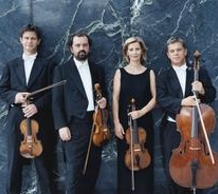
Hagen Quartet
Tonight I had the pleasure of hearing the Hagen Quartet play at the Konzerthaus (I am in Vienna and will be here for the next 2.5 months, so I am certainly looking forward to a lot of concerts!). This ensemble is one of the premier string quartets in the world and as usual they did not disappoint — except for the fact that they did not play an encore! The program was Beethoven op. 18/4, Bartók’s String Quartet no. 1, and Brahms’s op. 111 Quintet, also featuring Antoine Tamestit as the second viola. Needless to say, the performance was virtually flawless and highly appreciated by the crowd (except for some patrons who seemed unimpressed by the Bartók…but this is Vienna…).
I very much enjoyed their rendition of op. 18/4, the only minor quartet of Beethoven’s early works in this genre. Instead of maximizing the Sturm und Drang to open the first movement, they downplayed the drama, giving the melody almost a light texture. The Hagen Quartet is very skilled all around, but it would be hard to overstate how effectively they can play in the quieter ranges. In the Beethoven, this ability led to an almost delicate rendition of the initial theme. When it returned in the recapitulation, they then exploited its full dramatic potential, lending a cohesive narrative to the form and an inspired interpretation.
The Bartók is one of my favorites from his string quartets so I was very pleased to be able to hear the Hagen version. I have to say that I wanted more of a ‘seek and destroy’ sound in the last movement — one of my favorite memories of them was hearing them play the complete late Beethoven quartets over the course of a weekend, particularly their ‘seek and destroy’ approach to the Große Fuge. However, the lines were remarkably lucid, even the lowest parts in the viola and cello which normally sound like a vicious growl. This piece is fascinating because of its reliance on minor seconds: at first, they are not apparent, particularly because the opening stresses large intervals in the two violins, but what joins these bigger leaps are minor seconds. By the third (and final) movement, these minor seconds are almost unavoidable. One of Bartók’s most effective timbres is created by having one of the violins play the open E string simultaneously with a covered E on the neighboring A string. This piercing sound is then modified with minor seconds above and below it, creating tension that does not dissipate throughout the movement. The theme that appears after this effect also stresses minor seconds, as do many of the melodies, except for one of the most prominent. At two points, the music comes to a sudden stop (I felt that the Hagen Quartet could have stopped a little more suddenly, but this is a small quibble) with a lyrical, four-note melody in the first violin floating over the other parts. Unlike so much of the movement, the minor seconds suddenly disappear: the melody outlines a descending perfect fifth with whole step to a minor third then another whole step. However, the lyricism is thwarted by the anchoring accompaniment, which leaps up a tritone. While the intervals it forms with the melody are mostly consonant (starting with a minor third and ending on a major third), the tritone is jarring and unavoidable. One of my favorite characteristics of music from this era is precisely this tension between consonance and dissonance: the rules of traditional harmony are fading but not absent. In tonight’s concert, the Hagen Quartet produced an exquisite sound when after the first iteration, this theme was repeated at an astoundingly quiet dynamic.
The Brahms was also wonderful, although I prefer some of the composer’s other chamber works. Particularly during the second theme of the first movement the warm tone of the Hagen Quartet (with Tamestit) shone through. All in all, it was a wonderful concert experience and I was thrilled to have the opportunity to hear them live again.




Discussion
No comments for “Hagen Quartet at the Konzerthaus”